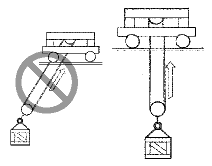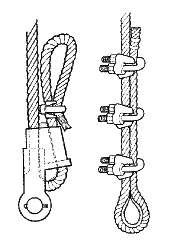Overhead Crane Operation |
What should you do before moving a load?
How should you move loads safely?
What should you do before leaving the crane?
What should you avoid when operating an overhead crane?
What should you do before moving a load?
- Ensure all loose materials, parts, blocking and packing have been removed from the load before lifting.
- Remove any slack from the sling and hoisting ropes before lifting the load.
- Make sure that the lifting device seats in the saddle of the hook.
- Move crane controls smoothly. Avoid abrupt, jerky movements of the load.
- Follow signals only from one slinger in charge of the lift, except a stop signal.
- Make sure everyone is away from the load before hoisting. Sound a bell, siren or other warning device and start to hoist slowly.
- Ensure nothing links or catches on the load while raising it or traveling.
- Ensure that nothing obstructs the movement of a load.
- Keep the load under control when lowering a load. If the braking system stops working, the load can usually be lowered by reversing the hoist controller to the first or second point.
- Stay in a crane cab during power failure. Attract attention and wait for help.
- Remove the load hanging on crane hooks.
- Raise all hooks to a mid position.
- Spot the crane at a designated location.
- Place all controls in the OFF position.
- Open the main switch to the OFF position.
- Do not carry anything in your hands when going up and down ladders. Items that are too large to go into pockets or belts should be lifted to or lowered from the crane by rope.
- Do not operate a crane if limit switches are out of order, or if cables show defects.
|
|
- Do not allow anyone to ride on a load or hooks.
- Do not leave slings dangling from the load hook. Have sling hooks placed on the sling ring when carrying slings to the load.
- Do not raise loads higher than necessary to clear objects.
- Do not pass a load over workers.
- Do not reverse a motor until it has come to a full stop except to avoid accidents.
- Do not walk on the crane runway.
- Do not leave suspended loads unattended.
Wire Rope Slings
How should you select the proper wire rope sling?
How should you use wire rope slings safely?
What should you avoid when using wire rope slings?
How should you select the proper wire rope sling?
- Follow the manufacturers' charts and tables on sling types, angles, and rope diameters.
- Follow the manufacturers' recommendations on clips and clamps of suitable size and design for ropes of different size.
|
|
- Use wire rope slings at rated limits.
- Examine slings for wear, fatigue, crushed or broken wires, kinking, ballooning or "bird-caging", heat damage, etc. Check both before and after using slings to detect any damage or defects.
- Inspect and tighten fittings regularly.
- Check the manufacturer's chart for sling properties.
- Reduce rope stress with slow starts and stops.
- Keep wire rope slings well lubricated and inspect them often.
- Remove damaged slings from service and tag appropriately.
- Store slings on racks in a clean, dry place.
- Center the sling load to prevent the load from shifting suddenly and causing a high impact load.
- Do not bend slings around sharp edges. Protect them by using corner saddles, padding, or wood blocks.
- Do not use slings with knots.
- Do not slide the load along a rope.
- Do not use a single leg hitch on a load that cannot be controlled. Rotation of a load can undo the wire rope strands and weaken the rope.
What should you avoid when slinging a load?
How should you sling a load onto a crane hook?
- Make clear signals according to standard signals. Refer to "Materials Handling - Crane and Hoist Hand Signals" for examples.
- Signal the crane operator from only the one slinger who is in charge of lift. The only exception is a stop signal. (A slinger or rigger is the person who hooks loads onto cranes using various types of slings.)
- Determine the weight of the load to be lifted.
- Select the right sling for each job using the manufacturers' tables. A slinger must be familiar with these tables showing the safe capacities of slings.
- Inspect each item of lifting equipment before and after lifts.
- Protect slings from damage by sharp edges with corner saddles, padding, or wooden blocks.
- Warn all people out of the load area before starting the lift.
- Protect your hands and fingers: when slack is being taken out of a sling, keep them from between the sling and load so they will not be trapped and crushed. Step away before the lift is made.
- Make sure a load is high enough to clear all objects before signaling for the crane to move.
- Walk ahead of the moving load and warn people to keep clear. Use guide ropes to prevent rotation or other uncontrolled motion.
- Hook unused sling legs to the sling ring.
- Do not exceed the capacities of slings, fixtures and cranes.
- Do not twist or tie knots in slings or use bolts, nails or pieces of wire to shorten slings.
- Do not splice together broken slings.
- Do not ride on hooks or loads.
- Do not allow workers to walk or work under a load.
- Do not attempt to pull or push loads to a spot that is not under the hoist.
- Do not drag slings. Avoid pulling slings out from under loads by crane. Set down loads on blocking, never directly on a sling.
- Do not leave unused slings, accessories, or blocking lying on the floor. Hang on racks or store in a proper place.
- Do not carry a load by inserting the point of the hook into a link of the chain.
- Do not hammer a sling into place.
- Do not leave loose materials on a load.
- Do not use slings that are stretched, broken, or defective. Tag them as defective and dispose of any damaged slings.
- Do not leave suspended loads unattended.











